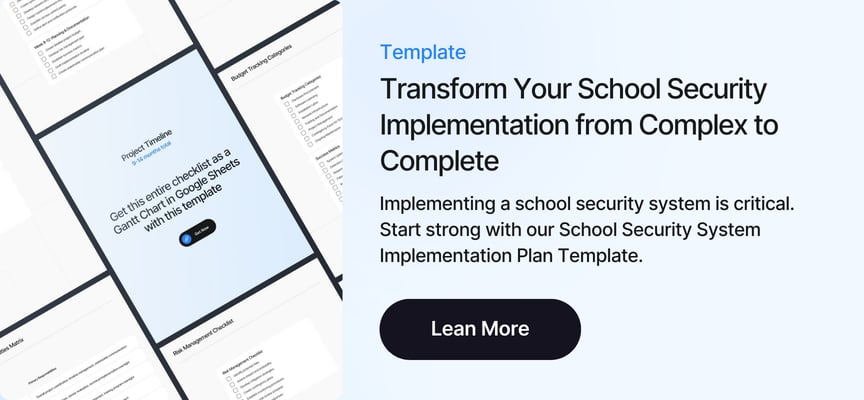Key Points
- School safety bonds can provide substantial funding through community support
- Capital improvement budgets can be strategically allocated for security technology
- Technology levies offer dedicated funding for modern security solutions
- General fund reallocation can help prioritize security without new funding sources
- Local partnerships and creative funding approaches can maximize security investments
Introduction
As school administrators face the critical task of enhancing campus safety, one of the most significant challenges is securing adequate funding for modern security systems. While state and federal grants provide valuable opportunities, local funding options often offer more immediate and sustainable solutions for implementing comprehensive security measures.
This guide explores practical, local-level funding strategies that public school administrators can leverage to enhance their security infrastructure. By understanding and utilizing these funding mechanisms effectively, schools can implement advanced security solutions without straining their existing resources.

School Safety Bonds: Building Community Support for Security
School safety bonds represent one of the most powerful tools for funding comprehensive security improvements. These voter-approved initiatives can provide substantial, dedicated funding for security infrastructure, including advanced AI-powered surveillance systems and emergency response technology.
To successfully pursue a school safety bond:
- Conduct a thorough security assessment to identify specific needs
- Develop a detailed implementation plan with clear cost projections
- Create compelling educational materials about security benefits
- Engage community stakeholders early in the planning process
- Host informational sessions to build understanding and support
The key to successful bond measures lies in clear communication about how the funds will enhance student safety. For example, many schools have successfully secured bond funding by demonstrating how modern security systems can reduce response times to emergencies and provide comprehensive campus monitoring.
Remember that timing is crucial when proposing safety bonds. Consider aligning these initiatives with regular election cycles to maximize voter turnout and minimize special election costs.
How District-Level School Security Bonds Are Proposed and Passed
While individual schools cannot independently propose or issue bonds, they can significantly influence district-wide bond initiatives through strategic advocacy and thorough preparation. The key is to build a compelling case that demonstrates both urgent need and community support.
Schools should start by conducting and documenting detailed security assessments, tracking safety incidents, and gathering support from stakeholders including parents, faculty, and local law enforcement.
With this foundation in place, schools should actively engage with district leadership by joining planning committees, contributing to needs assessments, and helping prioritize security projects. It's particularly effective when multiple schools within the district coordinate their efforts, presenting a unified case for security improvements. Schools should also be prepared to demonstrate how their security needs align with broader district goals and initiatives.
While working toward a potential bond, schools should simultaneously pursue complementary funding options such as grants, community fundraising, and district budget allocations. This shows initiative and commitment to addressing security needs through multiple channels.
Remember that districts are more likely to include specific school security needs in a bond proposal when schools demonstrate both urgent need and proactive engagement in finding solutions. Consider engaging security technology partners like VOLT AI early in the process to help develop comprehensive security plans that strengthen the case for district funding.
The key is to position your school's security needs within the larger context of district-wide safety improvements, while actively participating in and supporting the district's bond planning process. This collaborative approach, backed by solid documentation and community support, offers the best path to securing the necessary funding for crucial security improvements.
Read the Case Study: How a Public High School Transformed School Security
Leveraging Capital Improvement Budgets
Capital improvement budgets, traditionally used for infrastructure maintenance and upgrades, can be strategically allocated to include security technology investments. This approach recognizes that modern security systems are as essential to school infrastructure as traditional building components.
Key strategies for utilizing capital improvement funds include:
1. Integration Planning
- Combine security upgrades with scheduled renovations
- Identify opportunities to upgrade existing camera systems
- Plan for long-term scalability and maintenance
2. Cost Optimization
- Prioritize solutions that work with existing infrastructure
- Focus on systems requiring minimal structural changes
- Consider phased implementation approaches
3. ROI Documentation
- Track cost savings from prevented incidents
- Document reduced insurance premiums
- Calculate long-term maintenance savings
When presenting security improvements as capital investments, emphasize how modern systems can reduce operational costs while enhancing safety. For instance, AI-powered surveillance can reduce the need for additional security personnel while providing more comprehensive coverage.

How to Allocate Capital Improvement Budgets to School Security Systems
Capital Improvement Budgets can fund permanent security infrastructure improvements that have a useful life of three or more years and typically meet minimum cost thresholds of $5,000 or more.
Qualifying expenditures include video surveillance systems, access control systems, emergency notification infrastructure, and security command center equipment. However, CIB funds cannot be used for operational costs like security staff salaries, monthly monitoring fees, or routine maintenance.
The process of securing CIB funds for security improvements requires thorough documentation and strategic planning. Schools should start with a comprehensive security audit and develop a detailed project proposal that includes cost estimates, expected useful life calculations, installation specifications, and maintenance projections.

This documentation package then goes through a formal approval process, typically requiring review by facilities committees and final approval from the school board.To maximize CIB impact, schools should consider phased implementation approaches and look for opportunities to bundle security improvements with other capital projects like building renovations or technology upgrades.
A particularly effective strategy is focusing on security systems that integrate with existing infrastructure, which can lower overall costs while improving efficiency. Working with security technology providers like VOLT AI early in the planning process can help schools design solutions that meet CIB requirements while delivering maximum security value for their investment.
Technology Levies: Dedicated Funding for Modern Security
Technology levies offer a focused approach to funding security improvements by creating dedicated revenue streams for technological advances in schools. These voter-approved measures can specifically support the implementation of cutting-edge security solutions.
The key differences between technology levies and bonds are:
- Tech levies are typically shorter-term (4-6 years vs 20-30 years for bonds)
- Levy amounts are usually smaller than bond requests
- Levies often need renewal every few years
- Spending requirements are more flexible
- Focus is specifically on technology and its maintenance
How Technology Levies Work
The process of getting a technology levy on the ballot begins at the district level with a comprehensive technology needs assessment. School administrators should work with their district technology teams to document current security and technology gaps, develop a detailed plan for improvements, and create specific cost projections.
This assessment should include input from security professionals, teachers, IT staff, and other stakeholders to ensure all critical needs are addressed. Having concrete data about security vulnerabilities and clear solutions is essential for building a compelling case.
The next crucial step is presenting this information to the school board, as they must approve putting the levy on the ballot. The presentation should include detailed implementation plans, specific cost breakdowns, and clear explanations of how the funds will enhance student safety and security through technology improvements.
The board will need to officially vote to place the levy on the ballot, and timing is crucial - most states require decisions to be made 60-90 days before the intended election date. Districts typically aim for either special elections in February/April or regular election cycles, depending on state requirements and local voting patterns.
Once approved for the ballot, districts must establish a community education campaign to inform voters about the levy's purpose and benefits. This typically involves forming a campaign committee (separate from the district itself, as public funds cannot be used for advocacy), developing clear communication materials, and hosting information sessions.
The campaign should emphasize specific security improvements the levy will fund, such as AI-powered surveillance systems or emergency response technology, and clearly explain the tax impact on property owners. Success often depends on demonstrating how modern security technology can provide better protection while potentially reducing long-term costs through improved efficiency and incident prevention.
The period between board approval and the vote is critical for building community support. Schools should host technology demonstrations, provide tours highlighting security needs, and share success stories from districts with similar security implementations.
It's important to be transparent about costs while emphasizing the return on investment in terms of enhanced student safety. Districts that successfully pass technology levies typically start their planning and community engagement process 12-18 months before the intended vote, allowing time to build understanding and support among voters.
Successfully implementing a technology levy requires:
Strategic Planning
- Develop a comprehensive technology plan
- Include security systems in broader tech infrastructure
- Create clear implementation timelines
Community Education
- Demonstrate the role of technology in modern school safety
- Showcase specific security improvements to be funded
- Provide concrete examples of safety outcomes
Implementation Framework
- Establish clear oversight committees
- Create transparent reporting mechanisms
- Define success metrics and timelines
Technology levies are particularly effective when presented as part of a broader modernization initiative that includes both educational technology and security improvements.
Visit the full school security system funding resource center.
General Fund Reallocation: Strategic Budget Adjustments
While creating new funding sources is ideal, many schools can enhance security through strategic reallocation of existing general fund resources. This approach requires careful analysis and creative solutions to maximize available funds.
Consider these reallocation strategies:
1. Operational Efficiency Reviews
- Identify areas where automation can reduce costs
- Consolidate redundant systems
- Optimize resource allocation
2. Cost-Sharing Opportunities
- Partner with local law enforcement
- Share security resources between schools
- Develop district-wide security initiatives
3. Technology Integration
- Replace multiple systems with unified solutions
- Reduce manual monitoring costs
- Streamline security operations
Success in general fund reallocation often comes from demonstrating how modern security systems can actually reduce long-term operational costs while improving safety outcomes.
How to Go About Reallocating Funds
Schools have specific rules about which funds they can reallocate for security purposes, with most flexibility coming from discretionary portions of their general fund - typically only 2-5% of their total budget.
These discretionary funds might come from site-based budgets, supply and equipment allocations, professional development funds, or non-emergency facilities maintenance funds. However, it's crucial to understand that many funding sources are restricted and cannot be reallocated, including special education funding, Title I funds, grant-specific allocations, and federal program funds.
The reallocation process typically follows strict guidelines and timelines. Most schools can only make significant budget changes during annual budget planning, mid-year reviews, or quarterly assessments.
Any reallocation exceeding $25,000 usually requires school board approval, and schools must maintain minimum operating reserves. The approval process starts with department head reviews and principal authorization, then moves to the district budget office for compliance verification before reaching the school board for final approval.
As previously mentioned, the most successful reallocation strategies focus on efficiency-based changes and shared resource optimization. Schools should look for opportunities to modernize outdated systems, consolidate redundant services, and leverage technology for cost savings. This might include reallocating funds from outdated system maintenance, unused software licenses, or service contract optimizations.
Whatever approach is taken, schools must maintain detailed documentation of current allocations, proposed changes, impact assessments, and expected outcomes to support their reallocation requests and demonstrate clear security benefits while maintaining essential services.
Some key things to remember about fund reallocation:
- Only discretionary funds can be reallocated, typically 2-5% of total budget
- Most reallocations over $25,000 require board approval
- Changes can usually only be made during specific budget cycles
- Documentation and justification are crucial for approval
Building Local Partnerships and Support
Beyond traditional funding mechanisms, schools can enhance their security funding through strategic local partnerships and community support initiatives.
Effective partnership strategies include:
Business Partnerships
Engage local businesses in your security initiatives by developing structured sponsorship programs, matching fund opportunities, and advisory committees that create mutual value for both schools and corporate partners.
- Develop sponsorship programs for security initiatives
- Create matching fund opportunities
- Establish business advisory committees
Community Organizations
Leverage the power of local foundations, parent-teacher organizations, and community groups that have a vested interest in school safety and often have established fundraising capabilities and community influence.
- Partner with local foundations
- Engage parent-teacher organizations
- Collaborate with community safety groups
Local Government Cooperation
Form strategic partnerships with city and county agencies to share resources, coordinate safety initiatives, and develop joint funding proposals that benefit from economies of scale and shared expertise.
- Coordinate with city/county safety initiatives
- Share resources with municipal agencies
- Develop joint funding proposals
These partnerships can provide both direct funding and valuable in-kind support for security improvements.
Read the Complete Guide: The Future of School Security in the Modern Era
Conclusion: Creating a Comprehensive Funding Strategy
Successfully funding school security improvements often requires a combination of these approaches, tailored to your community's specific needs and resources. Start by:
- Assessing your current security needs and gaps
- Identifying available local funding mechanisms
- Building community support for security initiatives
- Developing a phased implementation plan
- Creating clear metrics for success
Remember that investing in modern security technology isn't just about preventing incidents – it's about creating an environment where students and staff feel safe and protected. By leveraging these local funding options strategically, schools can implement comprehensive security solutions that enhance safety while managing costs effectively.
Need help planning your school security system implementation? Contact VOLT AI for a customized assessment of your security needs and guidance on maximizing your security investment.




